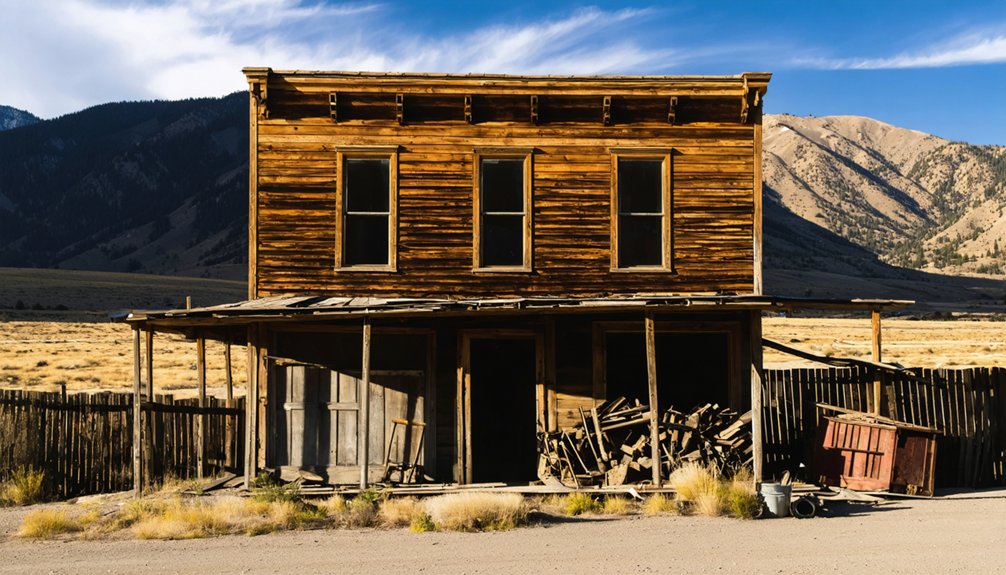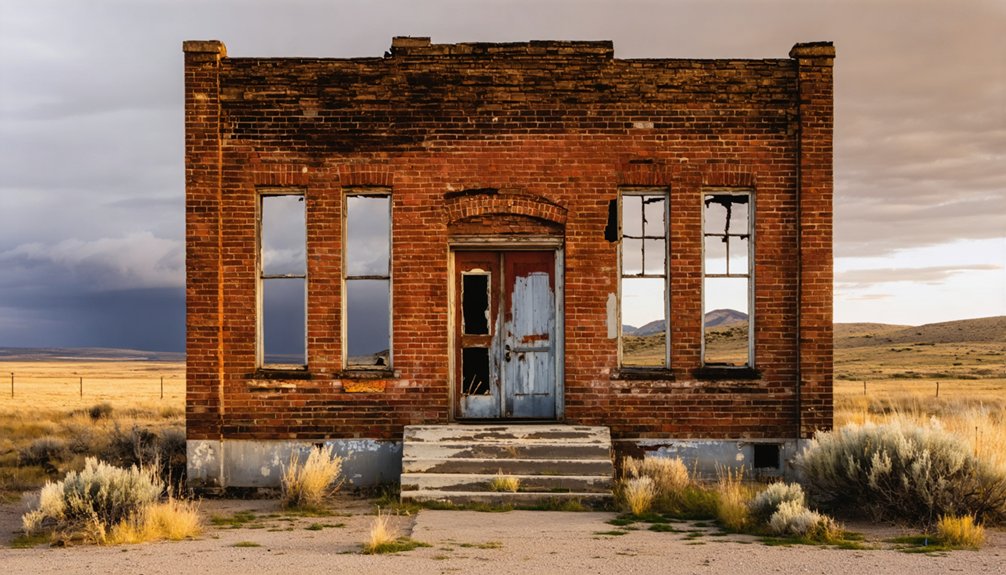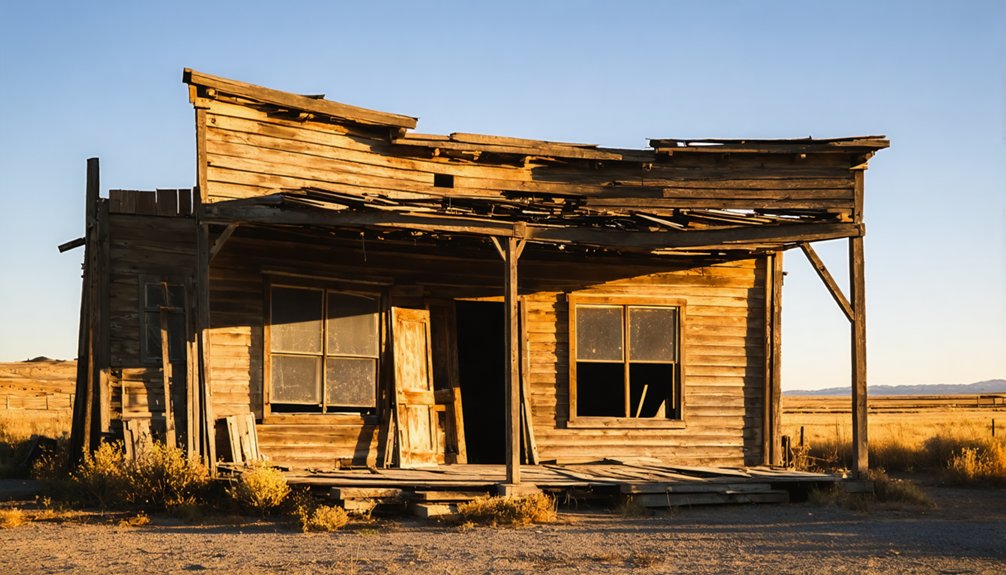You’ll find Atlanta, Idaho, a well-preserved ghost town at 5,383 feet in the Sawtooth Mountains, where gold was first discovered in 1863. The remote mining settlement flourished between 1876-1878, producing over $16 million in minerals through both placer and hardrock mining. Today, you can explore ten historic buildings in the National Register Historic District, accessible via Forest Road 268 from Boise. The town’s rugged isolation holds countless untold stories of frontier determination.
Key Takeaways
- Atlanta is a historic mining town established in 1863 after John Stanley’s gold discovery, producing over $16 million in mineral wealth.
- Located in Idaho’s Boise National Forest at 5,383 feet elevation, Atlanta remains remote with limited access via Forest Road 268.
- The town features twelve preserved historic buildings across a 10-acre National Historic District, showcasing original mining-era architecture.
- Despite its “ghost town” status, Atlanta maintains a small seasonal population and hosts preservation efforts through the Atlanta School.
- Access requires high-clearance 4WD vehicles, with no cell service and limited amenities available in the isolated mountain setting.
Gold Rush Origins: From Southern Pride to Mining Glory
While the California Gold Rush was winding down, Idaho’s mineral wealth remained largely untapped until John Stanley and his prospecting party discovered gold in the Atlanta area during the summer of 1863.
Initially keeping their find secret, they sparked an unsuccessful rush from Boise Basin that August. But when Stanley returned in 1864, you’d have found about a hundred determined miners working the Yuba River’s placer deposits.
Despite early secrecy, the prospect of gold drew hopeful miners to the Yuba River, where they toiled through harsh conditions.
The real mining glory began in November 1864, when John Simmons discovered the Atlanta lode, a significant gold and silver vein that transformed the district’s future. The area would eventually yield 297,000 ounces of gold throughout its productive history.
Despite the area’s remote location and harsh conditions, southern pride ran deep among the early prospectors who battled nature and isolation to establish what would become one of Idaho’s most productive mining regions. Over the years, the district produced an impressive over $16,000,000 in precious metals, though most of this wealth came after 1932.
Life in the Mountain Mining Town
The hardships of Atlanta’s early prospectors laid the groundwork for a remote but vibrant mountain mining community.
You’ll find that daily struggles defined life here – from battling harsh mountain conditions to dealing with limited supplies due to the town’s isolated location. Despite these challenges, community dynamics flourished during the peak mining years of 1876-1878, though high freighting costs and difficult ore processing tested everyone’s resilience.
Life improved considerably after 1932 when new technology made ore processing more efficient, and the 1936 construction of Middle Fork Road finally eased access to supplies. Much like Atlanta, Georgia’s roots as a railroad terminus hub, this mining town’s development was shaped by transportation access.
You can still experience traces of this determined community today in the ten preserved historic buildings, where residents once gathered while pursuing their fortunes in one of Idaho’s most productive mining regions. Today, visitors can explore Atlanta’s rich history within its ten-acre historic district while surrounded by the scenic Boise National Forest.
Natural Wonders and Geographic Challenges
Nestled within the Boise National Forest wilderness, Atlanta’s dramatic mountain setting showcases nature’s raw beauty alongside its inherent challenges.
You’ll find yourself surrounded by the rugged Sawtooth and Greylock Mountains, with the Middle Fork of the Boise River cutting through the landscape. First discovered in 1864 by miners, this area’s natural wealth drew prospectors seeking their fortune. The natural beauty extends to mineral-rich hot springs like Atlanta and Chattanooga, perfect for soaking after a day of outdoor adventure.
While the scenery’s breathtaking, accessibility challenges are real. You’ll need to navigate narrow, high mountain roads that wind through remote terrain. Located at 5,383 feet elevation, the town’s remote setting demands careful planning for visitors. There’s no cell service, and weather conditions can change rapidly.
Prepare for adventure but respect the wilderness – remote roads, no phone signal, and unpredictable mountain weather demand careful planning.
In winter, the town’s high elevation creates a playground for snowmobiling and skiing, but summer’s the prime time to explore this wilderness gem, where sagebrush flats meet pristine forest ecosystems.
Legacy of Mining Operations
You’ll find Atlanta’s mining evolution reflected in its shift from simple placer mining along the Yuba River in 1864 to sophisticated hardrock extraction methods by the 1930s.
The introduction of amalgamation-flotation concentrators in 1932 revolutionized ore processing, finally solving the persistent challenge of extracting minerals from refractory ore.
The district’s total production value exceeded $16 million, transforming Atlanta from a remote prospecting camp into a significant mining hub despite its challenging terrain and initial infrastructure limitations.
Mining Methods Evolution
While Atlanta’s mining story began with simple placer operations along the Yuba River in 1864, the discovery of the Atlanta lode that November sparked a dramatic evolution in mining methods.
You’d have found early miners using basic pans and sluices for placer mining, but the shift to underground mining demanded more sophisticated techniques. By 1866, quartz mills arrived to tackle the hard-rock extraction, though they struggled with the area’s refractory ores.
The real breakthrough came in 1932 when St. Joe Mining Company introduced an amalgamation-flotation concentrator, finally solving the complex ore processing challenge.
Modern operations have further evolved, abandoning cyanide heap leaching for a combined open-pit and underground approach. This newer method achieves an impressive 90% recovery rate while reducing environmental impact by 85%. However, ongoing issues with toxic arsenic discharge continue to plague the watershed, requiring constant monitoring and legal intervention.
Economic Impact Assessment
Despite its remote location delaying initial development, Atlanta’s mining operations generated over $16 million in historic production value, establishing the district as one of Idaho’s significant mineral producers.
You’ll find that economic trends shifted dramatically from the initial placer mining on the Yuba River to the discovery of the Atlanta lode in 1864, which sparked intensive gold and silver extraction operations.
The mining boom’s community resilience was tested when operations ceased in the 1930s as ore deposits ran out. While mining created substantial wealth and infrastructure during Atlanta’s heyday, you’ll now see a ghost town with a small remaining population.
Today’s economy relies primarily on heritage tourism and outdoor recreation, with the ten-acre historic district drawing visitors interested in the area’s mining legacy.
Historic Buildings and Preservation

The historic buildings of Atlanta, Idaho stand as remarkable symbols of the town’s mining-era prosperity, with 12 preserved structures spread across a 10-acre district that earned National Register of Historic Places status in 1978.
You’ll find unique wooden cabins and lodges that showcase early mining-town architecture, nestled within the picturesque Boise National Forest.
The Atlanta School spearheads historic preservation efforts through hands-on restoration courses and workshops. Students gain expertise in vernacular construction techniques through intensive training programs.
Despite challenges like remote location and harsh climate, you can participate in practical preservation techniques that help maintain these architectural treasures.
While limited resources and seasonal population fluctuations pose ongoing challenges, the district’s cultural significance draws visitors and supports local businesses.
The preserved structures continue to offer valuable insights into the region’s gold and silver mining heritage.
Getting There: Travel Tips and Access Routes
You’ll want to take Forest Road 268 (Middle Fork Boise River Road) from Boise to reach Atlanta, a challenging 65-mile journey that requires 2.5-4 hours and a high-clearance vehicle with 4WD recommended.
Before departing, fill your gas tank in Boise and pack emergency supplies, as there’s no cell service and limited amenities along the route.
The road is typically accessible from late spring through early fall, but winter travel isn’t advised due to snow and lack of maintenance.
The drive takes you along the scenic Middle Fork Boise River, where historic gold mining claims dot the landscape.
This remote route leads to rustic hot springs perfect for soaking after the long drive.
Best Routes to Atlanta
Reaching Atlanta, Idaho requires careful planning and navigation through a network of winding mountain roads.
You’ll find two main routes from Boise: either take Highway 21 east for 18 miles past Idaho City, then follow NF roads 384, 327, and 268; or head north on Highway 21 for 12 miles and turn onto Spring Shores/NF 268.
If you’re coming from Mountain Home, travel north on Highway 20 past Anderson Ranch, following NF 61 and 157 before connecting to NF 268.
For experienced pilots, the Atlanta Airport (55H) offers a 2,460-foot turf runway at 5,500 feet elevation.
Regardless of your chosen route, check current conditions before departing, as weather greatly impacts access.
Summer travel proves most reliable, while winter often demands high-clearance 4WD vehicles and mountain driving experience.
Vehicle Preparation Guidelines
Before starting your journey to Atlanta’s ghost town, proper vehicle preparation stands vital for traversing the challenging terrain of Idaho’s remote backcountry.
You’ll need a high-clearance 4WD vehicle equipped with robust tires and suspension. Make certain your vehicle maintenance is up-to-date, checking brakes, fluids, belts, and battery before departure.
Pack essential off-road equipment including a full-sized spare tire, tire repair kit, recovery gear, and emergency lighting.
Don’t forget traction mats, a winch, chains, and tow straps. Self-recovery tools like shovels and air compressors are important since roadside assistance is limited.
Fill your tank before leaving major towns, and consider carrying extra fuel.
With no cell service available, bring offline GPS and detailed paper maps to navigate the unmarked Forest Service roads confidently.
Seasonal Access Considerations
Accessing Atlanta’s ghost town requires careful timing and route planning throughout the year.
Summer offers the most reliable travel conditions when forest service roads are dry and well-maintained. During winter months, you’ll find Middle Fork River Road is your only maintained access route, while other paths become snowed in and impassable.
Spring and fall visits are possible but watch for washouts and ruts from snowmelt or rain.
Seasonal weather can create challenging conditions on the gravel and dirt roads leading to Atlanta, particularly after storms. You’ll want to check with Boise National Forest for current closures before departing, especially from late fall through early spring.
The roads’ conditions vary greatly based on recent weather and seasonal road maintenance schedules.
Local Legends and Cultural Heritage
While Atlanta’s physical structures have largely faded into history, the town’s rich cultural heritage lives on through its colorful local legends and preserved historic sites.
Local folklore centers around characters like “Peg Leg Annie,” who lost her leg to frostbite during an 1896 blizzard rescue attempt. These cultural narratives paint a vivid picture of frontier life’s challenges and triumphs.
Through tales like Peg Leg Annie’s heroic sacrifice, Atlanta’s folklore preserves the grit and determination of frontier life.
- The Atlanta Historic District preserves five original houses, outbuildings, and a jail from the mining era.
- The Atlanta Library serves as a repository of local history and community gathering space.
- The Beaver Lodge continues the tradition of bringing together locals and visitors.
You’ll find these stories kept alive by descendants of original miners, including recent residents like Miles, who’ve inherited tales of secret gold discoveries, fierce rivalries, and the untamed spirit of the American frontier.
Frequently Asked Questions
Are There Any Dangerous Abandoned Mine Shafts Visitors Should Watch Out For?
Yes, you’ll find dangerous abandoned mines west of Atlanta, including Hermada and Overlook mines. Stay on marked trails and don’t enter any shafts – they’re unstable and lack proper safety precautions.
What Are the Current Property Ownership and Real Estate Options in Atlanta?
You’ll find limited real estate listings through Elmore County, with most properties privately owned. You’re responsible for property taxes to the county since Atlanta’s unincorporated status affects ownership documentation.
Is There Cell Phone Service or Internet Connectivity in Atlanta?
You won’t find cell service in this remote area, but you can access internet via Wi-Fi at Beaver Lodge’s restaurant. Don’t expect connectivity in the cabins – you’re truly off-grid here.
What Wildlife Encounters Should Visitors Be Prepared for in the Area?
You’ll likely encounter mule deer, elk, and black bears in the Sawtooth Mountains. Keep food secured and stay alert for bear encounters. Rattlesnakes hide in rocky areas during summer months.
Are There Any Active Mining Claims or Operations Near Atlanta Today?
You’ll find over 650 active mining claims in the area, continuing Atlanta’s rich mining history. The local geology’s gold and silver deposits still attract modern mining operations using environmentally conscious methods.
References
- https://westernmininghistory.com/towns/idaho/atlanta/
- https://authorkevinkelley.com/2014/07/19/atlanta-idaho-cabins-and-locals/
- https://en.wikipedia.org/wiki/Atlanta
- https://history.idaho.gov/wp-content/uploads/2018/09/Atlanta_Historic_District_78001059.pdf
- http://idahotravelvacation.blogspot.com/2011/07/idaho-vacation-atlanta-idaho-mining.html
- https://visitidaho.org/things-to-do/ghost-towns-mining-history/atlanta-area/
- https://history.idaho.gov/wp-content/uploads/0202.pdf
- https://www.idahogeology.org/pub/Pamphlets/P-131.pdf
- https://www.atgoldinc.com/atlanta-gold-property/
- https://history.idaho.gov/wp-content/uploads/0172.pdf



